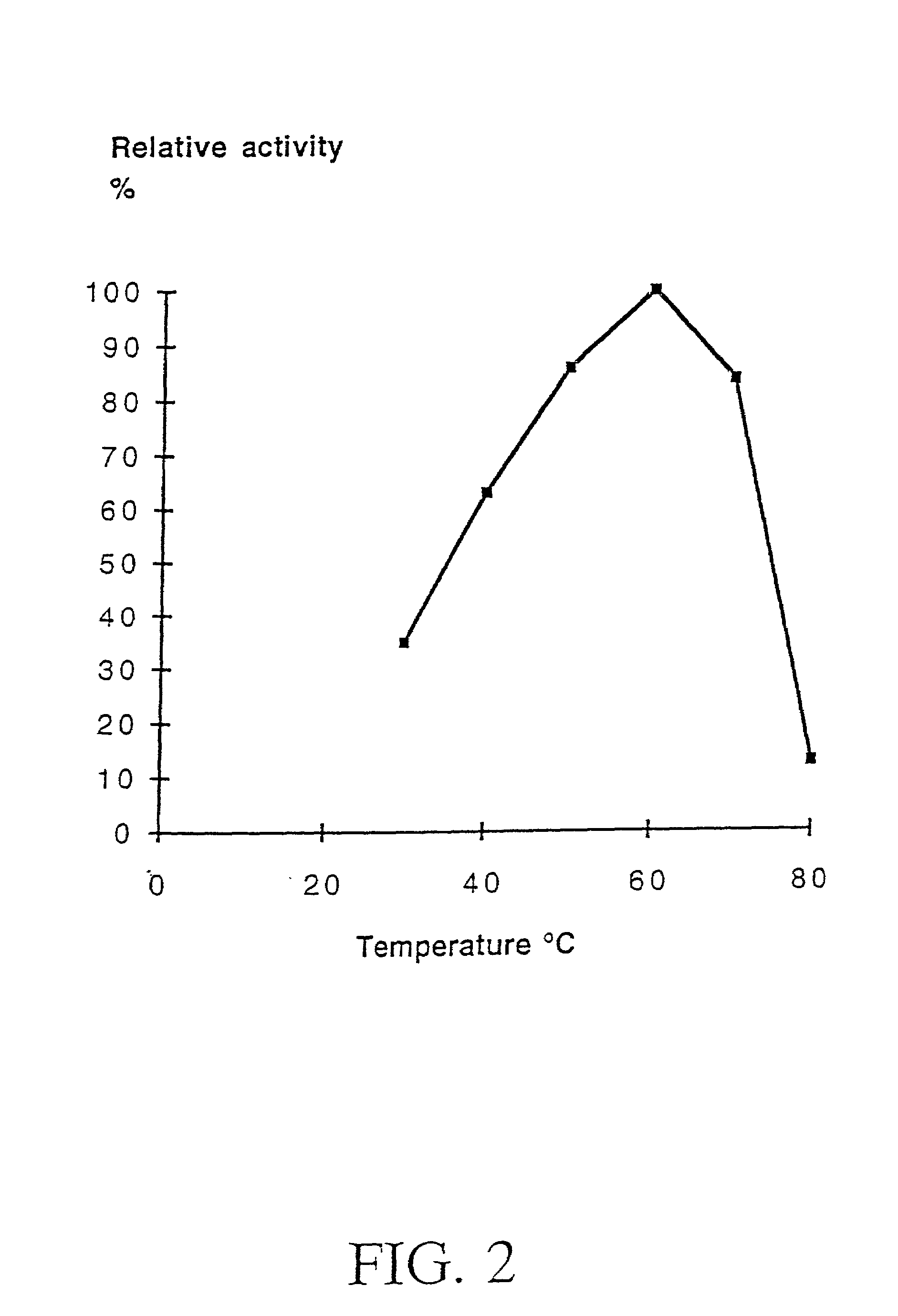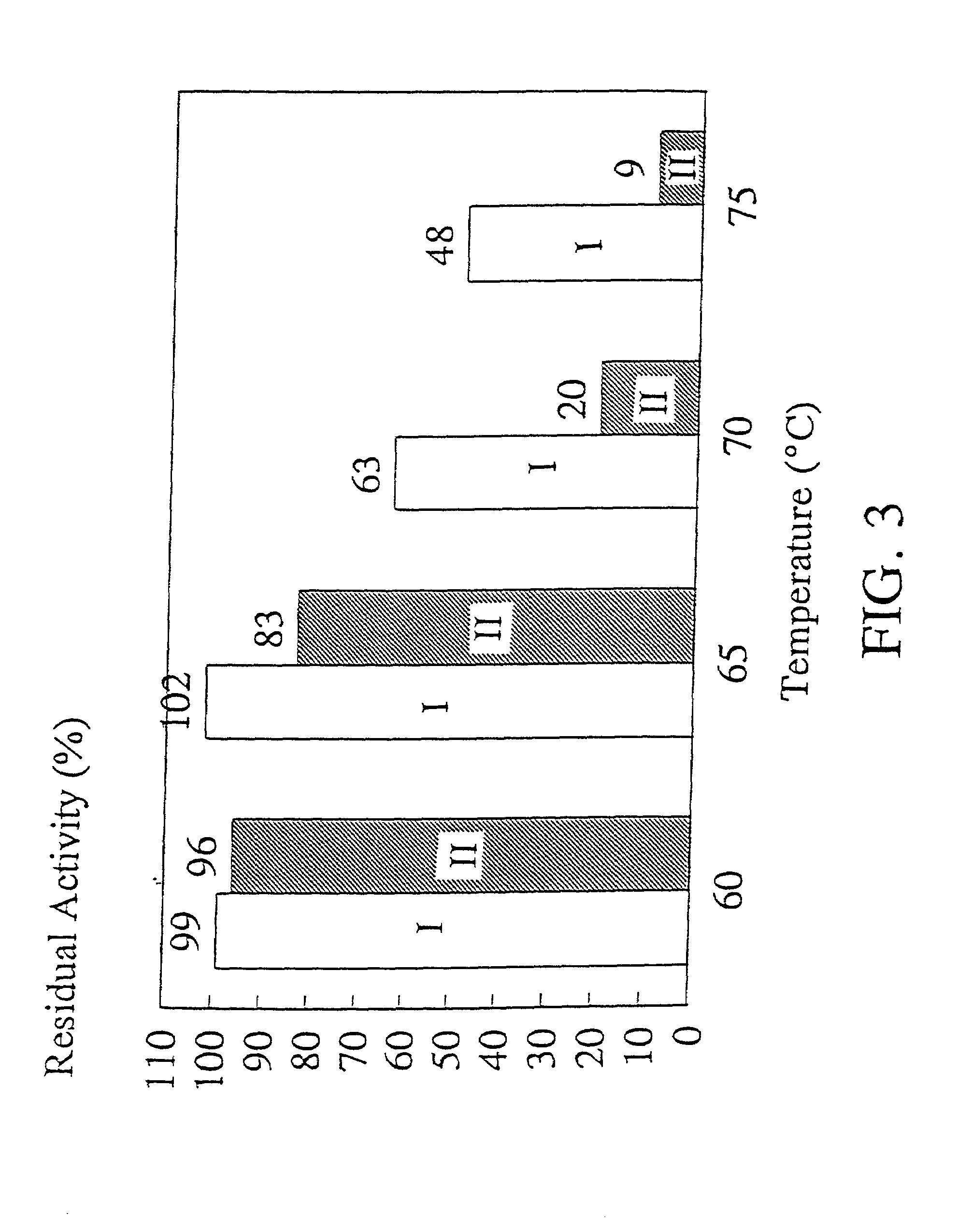Animal feed additives
a technology of animal feed and additives, which is applied in the field of animal feed additives, can solve the problems of the ability of the animals to digest, the use of a xylanase as a feed enhancing enzyme, and the type and amount of plant raw materials which can be used as components in animal feeds, etc., and achieves excellent thermostability, excellent feed enhancing, and improved feed utilization.
- Summary
- Abstract
- Description
- Claims
- Application Information
AI Technical Summary
Benefits of technology
Problems solved by technology
Method used
Image
Examples
example 1
Isolation of the Gene
[0161]A library from Thermomyces lanuginosus consisting of approx. 1.5×106 individual clones in 150 pools was constructed. DNA was isolated from 20 individual clones from the library and subjected to analysis for cDNA insertion. The insertion frequency was found to be >90% and the average insert size was approximately 1400 bp.
[0162]DNA from some of the pools was transformed into yeast, and 50–100 plates containing 200–500 yeast colonies were obtained from each pool. After 3–5 days of growth, the agar plates were replica plated onto several sets of agar plates. One set of plates containing 0.1% AZCL™ xylan (Megazyme™, Australia) was then incubated for 3–5 days at 30° C. to detect for xylanase activity. Positive colonies were identified as colonies surrounded by a blue halo. Alternatively, one set of plates was then incubated for 3–5 days at 30° C. before over-layering with a xylan overlayer gel containing 0.1% AZCL™ xylan and 1% agarose in a buffer with an approp...
example 2
Expression in Aspergillus
[0169]In order to express the gene in Aspergillus, cDNA is isolated from one of the above clones by digestion with HindIII / XbaI or other appropriate restriction enzymes, size fractionation on a gel and purification and subsequently ligated to pHD414, resulting in plasmid pA2XITl. After amplification in E. coli, the plasmid is transformed into a strain of Aspergillus oryzae according to the general procedure described in the Materials and Methods section above.
Test of Aspergillus oryzae Transformants
[0170]Each of the transformants were inoculated in 10 ml YPM medium. After 3–5 days of incubation at 30° C. and 250 rpm, the supernatant was removed. The xylanolytic activity was determined by applying 10 μl supernatant into 4 mm (diameter) holes punched in an agar plate containing 0.2% AZCL™ xylan (Megazyme™, Australia) in a buffer with an appropriate pH, and incubated overnight at 40° C. The xylanase activity was identified as described above. Some of the trans...
example 3
Purification Example
[0174]The culture supernatant from fermentation of Aspergillus oryzae, described in Example 2, expressing the recombinant enzyme is centrifugated and filtered through a 0.2 μm filter to remove the mycelia.
[0175]100 ml of the filtered supernatant is ultra-filtrated in a Filtron™ ultracette or Amicon™ ultrafiltration device with a 3 kDa membrane to achieve 10 fold concentration. This concentrate is diluted 100 times in 20 mM TRIS, pH 8.0, in two successive rounds of ultrafiltration in the same device. This ultrafiltration sample is loaded at 2 ml / min on a Pharmacia XK 26 / 20 Fast Flow Q Sepharose™ anion exchanger, equilibrated in 20 mM TRIS, pH 8.0.
[0176]After the sample has been applied, the column is washed with two column volumes 25 mM TRIS, pH 8.0, and bound proteins are eluted with a linear increasing NaCl gradient from 0 to 0.5 M NaCl in 25 mM TRIS, pH 8.0. Fractions are collected and the xylanase activity in the fractions measured as described above.
[0177]Xyl...
PUM
| Property | Measurement | Unit |
|---|---|---|
| pH | aaaaa | aaaaa |
| pH | aaaaa | aaaaa |
| temperature | aaaaa | aaaaa |
Abstract
Description
Claims
Application Information
 Login to View More
Login to View More - R&D
- Intellectual Property
- Life Sciences
- Materials
- Tech Scout
- Unparalleled Data Quality
- Higher Quality Content
- 60% Fewer Hallucinations
Browse by: Latest US Patents, China's latest patents, Technical Efficacy Thesaurus, Application Domain, Technology Topic, Popular Technical Reports.
© 2025 PatSnap. All rights reserved.Legal|Privacy policy|Modern Slavery Act Transparency Statement|Sitemap|About US| Contact US: help@patsnap.com



